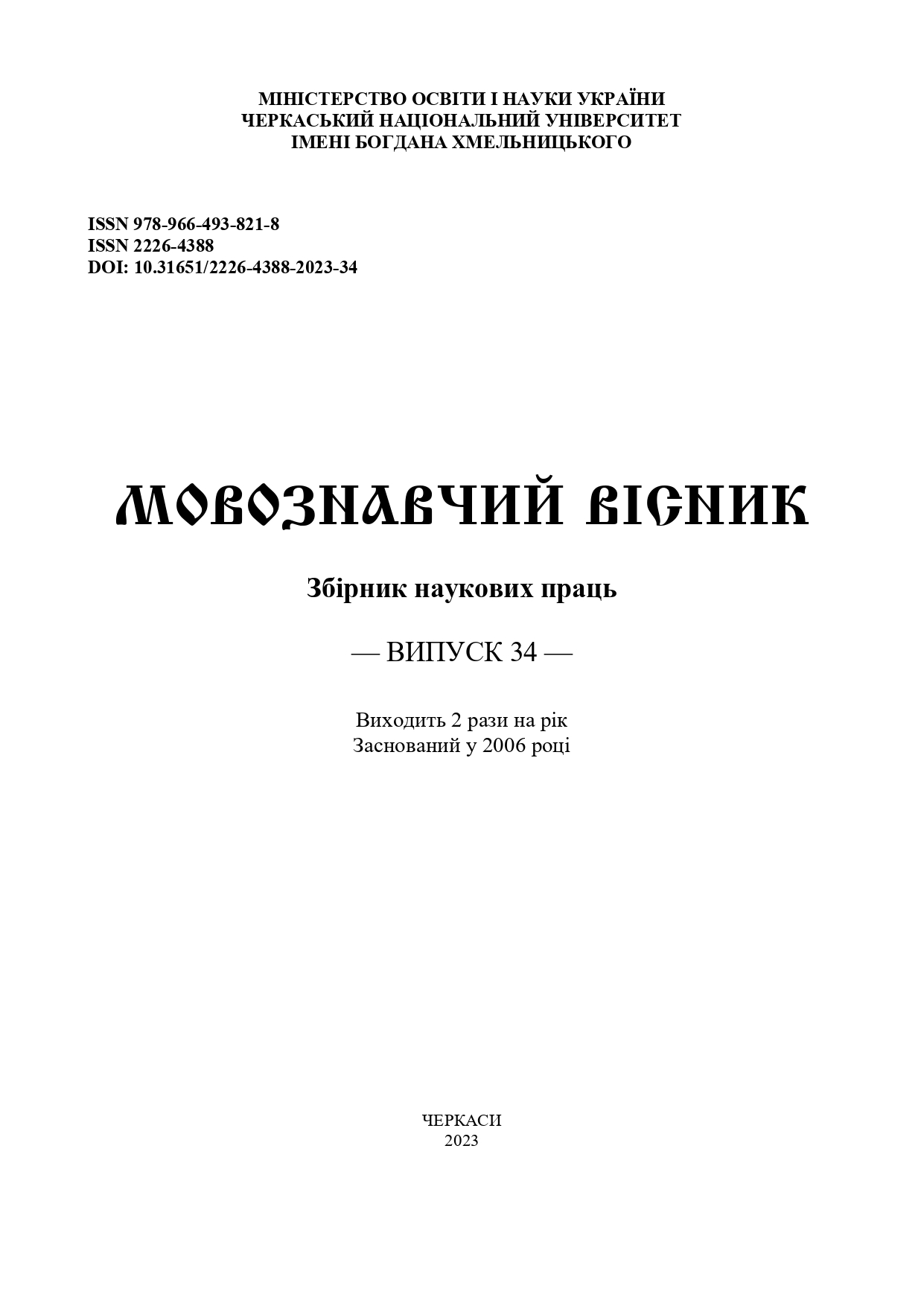THE COSSACK’S LEXICON LINGUISTIC UNITS IN P. KULISH–I. POLYUI’S UKRAINIAN TRANSLATION OF THE BIBLE AND B. GRINCHENKO’S «UKRAINIAN LANGUAGE DICTIONARY»
Main Article Content
Abstract
Introduction. The article presents the complex linguistic analysis of the Cossack’s sociolect
units used in P. Kulish and I. Polyui’s Ukrainian translation of the Holy Scriptures, along with their
representation in B. Grinchenko’s Ukrainian language dictionary. Herein lies the relevance of the research
which will serve as the basis for the futher generalizing works on history of the lexicographical
authentication and functioning of such lexemes in the literary language of the second half of XIX – early XX century.
The list of sources is known to be used by Grinchenko at the conclusion of the Dictionary includes
some examples of P. Kulish’s tranlation practice, in particular: the New Testament of the Holy Scriptures
(1880), «Books of Job» (1869), the first five books of the Holy Scriptures’ Old Testament and the New
Testament (1869). This fact confims securing high style vocabulary in Ukrainian lexicography in the early
XX century. It is worth emphasizing that B. Grinchenko also brought in the original writer’s works to the list
of sources, since there were extremely successful combining folk material with traditions of the old book
language in their content.
The purpose. The main objective of the research is to analize the representation of the Cossack’s
sociolect units in P. Kulish and I. Polyui’s Ukrainian translation of the Bible and illustrative contexts to the
mentioned lexemes in B.Grynchenko’s Ukrainian language dictionary. The material for the research are old
Cossack’s sociolect units compiled from different thematic groups, in particular: names of Cossack’s
chieftains: hetman, osavul, starshyna, sotnik, tysiachnyk; names of military units: kish; names of military
attributes and symbols of power: kleinod; weapons’ names: sagaidak, tarcha, shchyt; names of fabrics:
blavat, karmazin.
The methods. Description and comparative methods of the research are mostly applied when
analyzing these lexemes.
Maine results of the study. The main conclusions of the research lie in the fact that Cossack’s
sociolect units which were used in the Ukrainian translation of the Bible’s books are presented in
Grinchenko’s dictionary with illustrative contexts both in translated and original Kulish’s works. It states
their broad representation in the Dictionary’s source base and proves P. Kulish and B. Grinchenko’s
important role in preserving of the Cossack’s sociolect units along with their representation in the literary
language of the second half of XIX – early XX century and Ukrainian lexicography at the beginning of XX
century.
Originality. The scientific novelty of the research’s obtained results lies in implementing of the
comprehensive study on the representation of the Cossack’s sociolect in P. Kulish–I. Polyui’s Ukrainian
translation of the Holy Scipture, as well as theirs processing among the various lexicographical sources in
B. Grinchenko’s “Ukrainian language dictionary”.
Conclusions and specific suggestions of the author. The conducted research has shown the relevance
of historical and literary specialized or elected courses on studying Cossack’s era in the history of Ukraine
and lexicographical representation of Cossack’s sociolect units. This could lay the foundation for the
comprehensive historical and philological edition. The Cossack’s sociolect dictionary with illustrative
contexts both P. Kulish’s original heritage and other Ukrainian authors, specializing in the respective
sphere, is expected to have a great practical value. This too seems to be crucial, since after Grinchenko’s
Dictionary such practice, unfortunately, didn’t find its continuation.
Article Details
References
Hirniak, S. P. (2012). Osoblyvosti sotsiolektu yak systemno-strukturnoho yavyshcha [Peculiarities of the
sociolect as a systemic and structural phenomenon]. In : Visnyk Donetskoho natsionalnoho universytetu [Bulletin of the
Donetsk National University]. Ser. B: Humanitarni nauky. 1–2, 146–155 (in Ukr.).
Horbach, O. (2006). Argo v Ukraini [Argo in Ukraine]. Lviv : Instytut ukrainoznavstva im. I. Kryp’iakevycha
NAN Ukrainy, 686 (in Ukr.).
Masenko, L. Usni formy pobutuvannia movy. Yavyshche vulharyzatsii movlennia [Oral forms of everyday
language. The phenomenon of vulgarization of speech]. Available at: http://www.ji.lviv.ua/n35texts/35-zmist.htm (in
Ukr.).
Matsiuk, H. P. (2012). Sotsiolinhvistyka yak intehratsiinyi napriam doslidzhen v umovakh suchasnoi
paradyhmy: mizhnarodnyi dosvid y ukrainska perspektyva [Sociolinguistics as an integrative direction of research in
the conditions of the modern paradigm: international experience and Ukrainian perspective]. In : Naukovi zapysky
NaUKMA. Filolohichni nauky [Scientific notes of NaUKMA. Philological sciences], 137, 28–34 (in Ukr.).
Moroz, T. (2013). Tserkovonoslov’ianizmy bibliinykh perekladiv P. Kulisha u Slovnyku B. Hrinchenka
[Church Slavonicisms of Bible translations by P. Kulish in the Dictionary of B. Grinchenko]. In : Naukovyi visnyk
Chernivetskoho universytetu: zbirnyk naukovykh prats [Scientific bulletin of Chernivtsi University: collection of
scientific papers]. Vyp. 659. Romano-slov’ianskyi dyskurs. Chernivtsi: Chernivetskyi nats. un-t, 149–154 (in Ukr.).
Simovych, V. (2005). Kulisheva mova y «kulishivka» [Kulish’s language and «Kulishivka»]. In : Pratsi u
dvokh tomakh [Works in two volumes]. Chernivtsi : Knyhy–XXI, 2005.T. 1: Movoznavstvo, 336–340 (in Ukr.).
Stavytska, L. (2005). Argo, zharhon, slenh: Sotsialna dyferentsiatsiia ukrainskoi movy [Argo, jargon, slang:
Social differentiation of the Ukrainian language]. Kyiv : Krytyka, 464 (in Ukr.).
Tkach, L. (2000). Sotsiolekt dukhovnoi verstvy yak osnova formuvannia typovykh oznak halytskobukovynskoho slovovzhytku kintsia XIX – pochatku XX st. [The sociolect of the spiritual stratum as the basis for the
formation of typical features of the Galician-Bukovyna vocabulary of the end of the 19th and the beginning of the 20th
centuries]. In : Bibliia i kultura: zb. nauk. st. [The Bible and culture: coll. of science Art]. Chernivtsi: Ruta, 6, 405–419
(in Ukr.).
Cherkez, I. (2010). Epistoliarii kintsia ХІХ – pochatku ХХ st. yak dzherelo doslidzhennia sotsiolektu
ukrainskoi intelihentsii [Epistolary of the late 19th and early 20th centuries. as a source of research on the sociolect of
the Ukrainian intelligentsia]. In : Mova i suspilstvo [Language and society]. Lvivskyi natsionalnyi universytet imeni
Ivana Franka, 1, 71–76 (in Ukr.).

